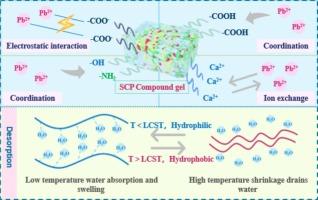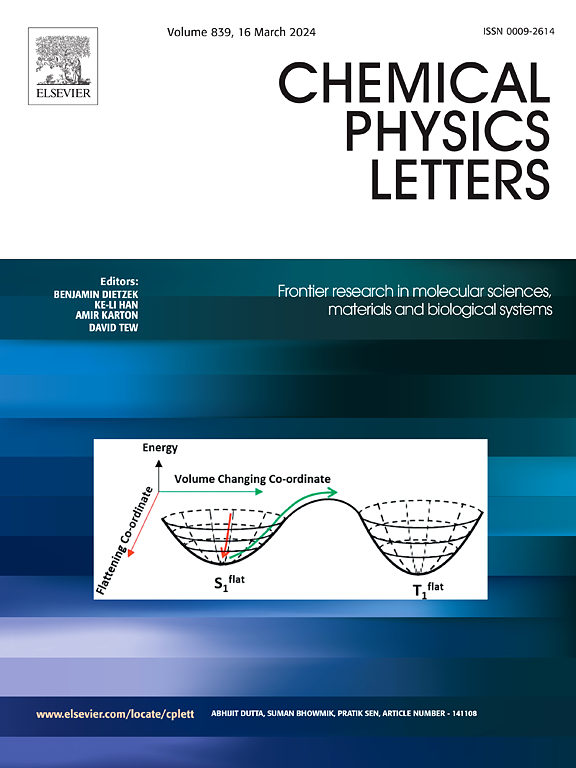热响应互穿网络水凝胶高效动态吸附Pb(II)的协同设计
IF 3.1
3区 化学
Q3 CHEMISTRY, PHYSICAL
引用次数: 0
摘要
热响应材料是一类新型的功能材料,能够根据环境温度变化进行可逆的膨胀、收缩或相变,在环境修复中显示出巨大的潜力。本研究以海藻酸钠(SA)和羧甲基纤维素钠(CMC)为基体,掺入热敏聚合物聚n -异丙基丙烯酰胺(PNIPAM),成功合成了具有互穿网状结构的复合水凝胶。SCP复合凝胶通过对表面亲水性的温度依赖性调节,实现对Pb(II)的控制吸附和释放。在较低的温度下,材料表面暴露出亲水性基团,从而获得高达311 mg g−1的高Pb(II)吸附量。当温度超过较低的临界溶液温度(LCST)时,发生构象转变,导致亲水性基团的隐藏和随后吸附的Pb(II)的释放。这种可调的方法确保了材料优越的再生性能。通过等温吸附模型和动力学模型的拟合,进一步验证了实验数据的可靠性。本研究表明,SCP复合水凝胶是一种经济高效的Pb(II)吸附剂,在重金属废水处理中具有重要的应用价值。本文章由计算机程序翻译,如有差异,请以英文原文为准。

Synergistic design of thermoresponsive interpenetrating network hydrogels for efficient and dynamic Pb(II) adsorption
Thermo-responsive materials represent a novel class of functional materials capable of reversible swelling, contraction, or phase transition in response to environmental temperature changes, demonstrating vast potential in environmental remediation. This study successfully synthesized a composite hydrogel with interpenetrating network structure, using sodium alginate (SA) and sodium carboxymethyl cellulose (CMC) as the matrix, and incorporating the thermo-sensitive polymer poly(N-isopropylacrylamide) (PNIPAM). The SCP composite gel enables controlled adsorption and release of Pb(II) through temperature-dependent regulation of surface hydrophilicity. At lower temperatures, hydrophilic groups are exposed on the material surface, resulting in a high Pb(II) adsorption capacity of up to 311 mg g−1. When the temperature exceeds the lower critical solution temperature (LCST), a conformational transition occurs, leading to the concealment of hydrophilic groups and subsequent release of adsorbed Pb(II). This tunable approach ensures superior regeneration performance of the material. The reliability of the experimental data was further validated by fitting with isothermal adsorption models and kinetic models. This study has shown that SCP composite hydrogel is a cost-effective and highly efficient adsorbent for Pb(II), holding significant application value in the treatment of heavy metal wastewater.
求助全文
通过发布文献求助,成功后即可免费获取论文全文。
去求助
来源期刊

Chemical Physics Letters
化学-物理:原子、分子和化学物理
CiteScore
5.70
自引率
3.60%
发文量
798
审稿时长
33 days
期刊介绍:
Chemical Physics Letters has an open access mirror journal, Chemical Physics Letters: X, sharing the same aims and scope, editorial team, submission system and rigorous peer review.
Chemical Physics Letters publishes brief reports on molecules, interfaces, condensed phases, nanomaterials and nanostructures, polymers, biomolecular systems, and energy conversion and storage.
Criteria for publication are quality, urgency and impact. Further, experimental results reported in the journal have direct relevance for theory, and theoretical developments or non-routine computations relate directly to experiment. Manuscripts must satisfy these criteria and should not be minor extensions of previous work.
 求助内容:
求助内容: 应助结果提醒方式:
应助结果提醒方式:


